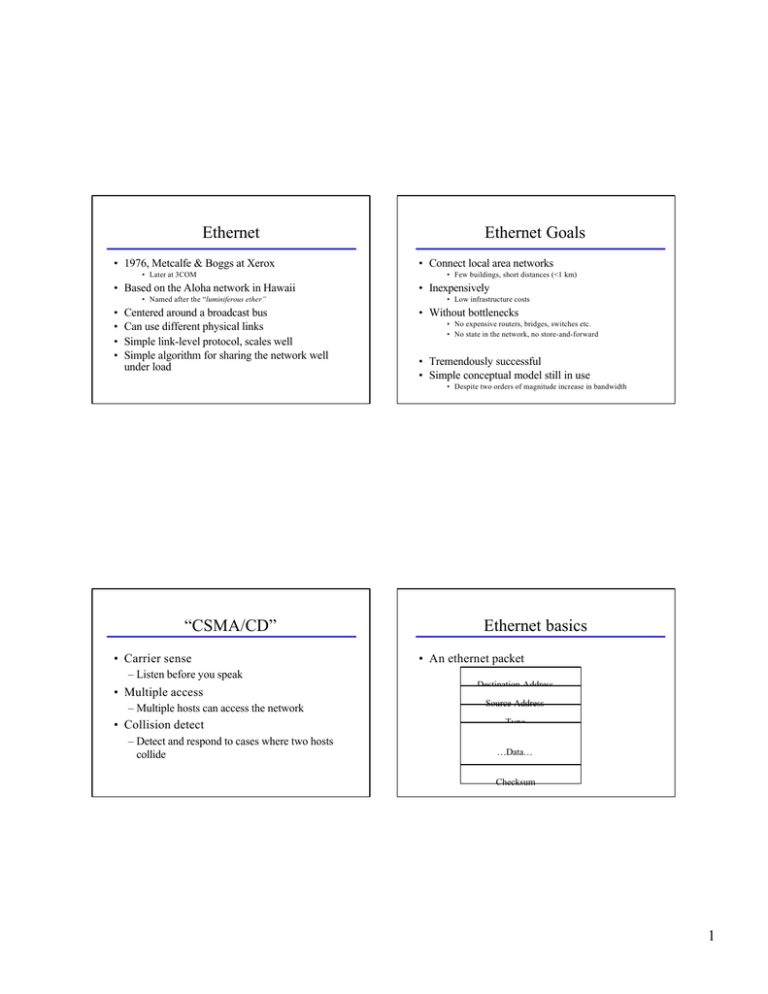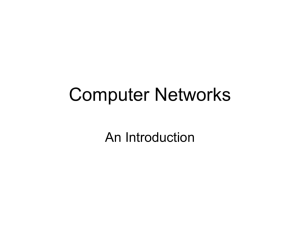Ethernet Ethernet Goals “CSMA/CD” Ethernet basics
advertisement

Ethernet • 1976, Metcalfe & Boggs at Xerox • Later at 3COM • Based on the Aloha network in Hawaii • Named after the “luminiferous ether” • • • • Centered around a broadcast bus Can use different physical links Simple link-level protocol, scales well Simple algorithm for sharing the network well under load Ethernet Goals • Connect local area networks • Few buildings, short distances (<1 km) • Inexpensively • Low infrastructure costs • Without bottlenecks • No expensive routers, bridges, switches etc. • No state in the network, no store-and-forward • Tremendously successful • Simple conceptual model still in use • Despite two orders of magnitude increase in bandwidth “CSMA/CD” • Carrier sense Ethernet basics • An ethernet packet – Listen before you speak • Multiple access – Multiple hosts can access the network • Collision detect – Detect and respond to cases where two hosts collide Destination Address Source Address Type …Data… Checksum 1 Sending packets Addressing & ARP 128.84.96.89 128.84.96.90 128.84.96.91 “What is the physical address of the host named 128.84.96.89” “I’m at 1a:34:2c:9a:de:cc” • Carrier sense, broadcast if ether is available • ARP is used to discover physical addresses • ARP = Address Resolution Protocol Addressing & RARP ??? Collisions 128.84.96.90 RARP Server 128.84.96.91 “I just got here. My physical address is 1a:34:2c:9a:de:cc. What’s my name ?” “Your name is 128.84.96.89” • RARP is used to discover virtual addresses • RARP = Reverse Address Resolution Protocol • What happens if two people decide to transmit simultaneously ? 2 Collision Detection & Retransmission Collisions • The hosts involved in the collision stop data transmission, sleep for a while, and attempt to retransmit • How long they sleep is determined by how many collisions have occurred before • They abort after 16 retries, hence no guarantee that a packet will get to its destination • Advantages: – Packet can be retransmitted at the link level immediately without high-level timeouts, – Packets are truncated early to avoid wasting bandwidth – Collision rates can be used to gauge net usage Odds & Ends • Minimum packet size is 64 bytes, which is just right for the given length for all hosts to detect a collision • Truncated packets are filtered out of the network • CRC is used to detect malformed packets, e.g. electrical interference, noise • What happens if the packets are really short ? Ethernet Features • Completely distributed • No central arbiter • Inexpensive • No state in the network • No arbiter • Cheap physical links (twisted pair of wires) 3 Ethernet Problems • The endpoints are trusted to follow the collision-detect and retransmit protocol • Certification process tries to assure compliance • Not everyone always backs off exponentially • Hosts are trusted to only listen to packets destined for them • But the data is available for all to see • Can place ethernet card in promiscuous mode and listen Ethernet Lessons • Best-effort delivery simplifies network design • A simple, distributed protocol can tolerate failures and be easy to administer • Networking infrastructure represents a large sunk cost • Best to keep it simple • Interoperable • Hard to upgrade means change occurs infrequently, when the gains are sizeable 4



